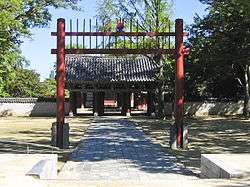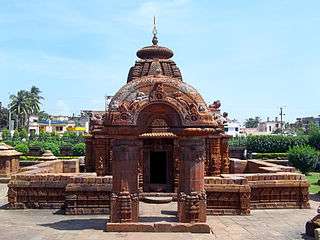Torana
For the Australian car, see Holden Torana.

A toran or torana is a type of gateway seen in the Hindu, Buddhist and Jain architecture of the Indian subcontinent, Southeast Asia and East Asia.
Meaning and uses of torana
Toranas are associated with Buddhist stupas like the Great Stupa in Sanchi, as well as with Jain and Hindu structures, and also with several secular structures. Symbolic toranas can also be made of flowers and even leaves and hung over the doors and at entrances, particularly in Western and Southern India. They are believed to bring good fortune and signify auspicious and festive occasions. They can also serve didactic and narrative purposes or be erected to mark the victory of a king.[1]
During Vesak festival of Sri Lanka it is a tradition to erect electrically illuminated colorful Vesak toranas in public places. These decorations are temporary installations which remain in public display for couple of weeks starting from the day of Vesak.
Toranas are also referred to as vandanamalikas. There are many different types of toranas - dvara-toranas, patra-toranas, ratne-toranas and so on. These are mentioned in medieval Indian architectural treatises.[2]
History
The earliest archaeological evidence of Torana dates back to Sanchi stupa built by Mauryan Empire in 3rd century BCE. The Sanchi torana and architecture is imitation of timber and brick construction in stone, which was popular feature in Indian architecture before 3rd century BCE.
Both Chinese paifang gateways and Japanese torii gateways have been derived from the Indian torana.[3] The functions of all three are similar, but they generally differ based on their respective architectural styles, such as having multiple tiered and arched roofs and various "supporting posts" that are prevalent in East Asian architectural style.[4][5] The Korean gateway is also related to the Japanese torii, and similar structures exist in Thailand.
A great deal of cultural exchange between these countries took place in ancient times, so that many Indian, Thai, Chinese, Korean and Japanese cultural practices are related. For example, Benzaiten is a Japanese name for the Hindu goddess Saraswati, and the ancient Siddhaṃ script, which disappeared from India by 1200 CE, is still written by monks in Japan.
In Kalinga architecture we can see the Toran in many temples built from the 7th to 12th centuries. Jagannath Temple, Puri, Rajarani Temple and Mukteswar Temple are the few example of Kalinga architecture having torana.
| Related styles | ||||||||||
|---|---|---|---|---|---|---|---|---|---|---|
|
See also
References
- ↑ Parul Pandya Dhar, (2010). The Torana in Indian and Southeast Asian Architecture, (New Delhi: D K Printworld,).
- ↑ Parul Pandya Dhar (2010): The Torana in Indian and Southeast Asian Architecture. New Delhi: D K Printworld. ISBN 978-8124605349.
- ↑
- ↑ Ronald G. Knapp (2000). China's old dwellings. University of Hawaii Press. p. 85. ISBN 0-8248-2214-5.
- ↑ Simon Foster; Jen Lin-Liu; Sharon Owyang; Sherisse Pham; Beth Reiber; Lee Wing-sze (2010). Frommer's China. Frommers. p. 435. ISBN 0-470-52658-0.
- Joseph Needham: Science and Civilization in China, Vol 4, part 3, p137-138.
- Ram Nath (1995): Studies in Medieval Indian Architecture. M.D. Publications Pvt. Ltd. 172 pages. ISBN 81-85880-56-5
- Nick Edwards, Mike Ford, Devdan Sen, Beth Wooldridge, David Abram (2003): The Rough Guide to India. Rough Guides. 1440 pages. ISBN 9781843530893.

.jpg)


